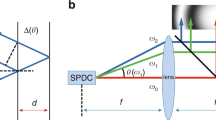Abstract
IT has been recently reported by Gross and Vuks1 that, in the light scattered by some organic crystals, there are a few lines or bands very close to the Rayleigh line. The origin of these lines has been attributed to lattice oscillations in the crystals. It has been further pointed out by these authors that these lattice oscillations persist even in the liquid state, but, owing to the looseness of the oscillations in the liquid state, these lines spread out so as to form a continuous wing on both sides of the Rayleigh line. According to these authors, the major portion of the wing is thus due to the persistence of these lattice oscillations in the quasi-crystalline groups present in the liquid, and only the portion very close to the Rayleigh line which increases in intensity with the rise of temperature may be connected with the rotation of the molecules in the liquid. If this hypothesis be correct, the intensity of the portion of the wing very close to the Rayleigh lines should increase and that of the other portions should diminish on dissolving a liquid in a solvent which itself gives a very feeble wing, because the quasi-crystalline groups of the solute should disappear or at least their number should diminish considerably in the solution.
This is a preview of subscription content, access via your institution
Access options
Subscribe to this journal
Receive 51 print issues and online access
$199.00 per year
only $3.90 per issue
Buy this article
- Purchase on Springer Link
- Instant access to full article PDF
Prices may be subject to local taxes which are calculated during checkout
Similar content being viewed by others
References
NATURE, 135, 100, 431; 1935.
S. C. Sirkar and B. B. Maiti, Ind. J. Phys., 9, 323; 1935.
Author information
Authors and Affiliations
Rights and permissions
About this article
Cite this article
SIRKAR, S. Origin of the Wing accompanying the Rayleigh Line in Liquids. Nature 136, 759–760 (1935). https://doi.org/10.1038/136759b0
Published:
Issue Date:
DOI: https://doi.org/10.1038/136759b0
Comments
By submitting a comment you agree to abide by our Terms and Community Guidelines. If you find something abusive or that does not comply with our terms or guidelines please flag it as inappropriate.



